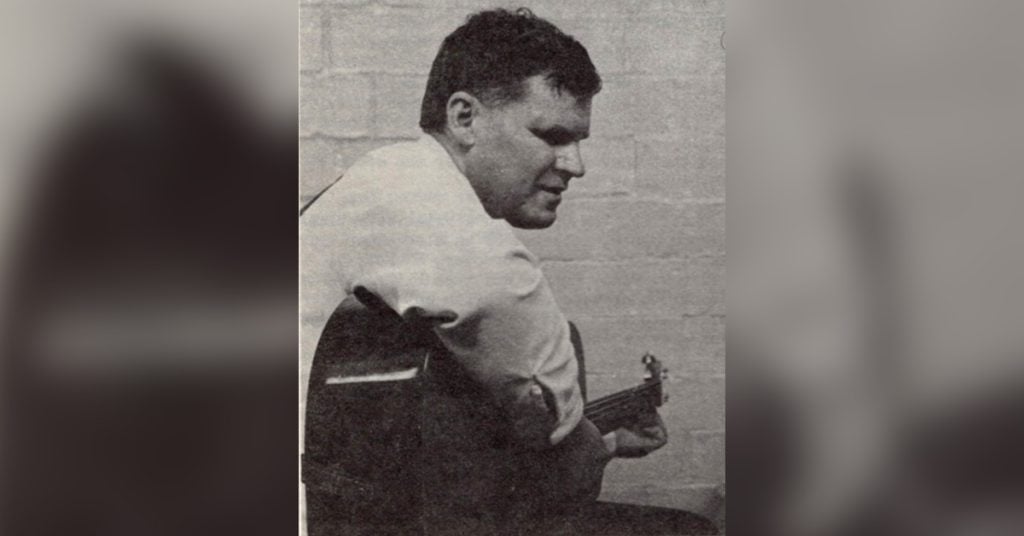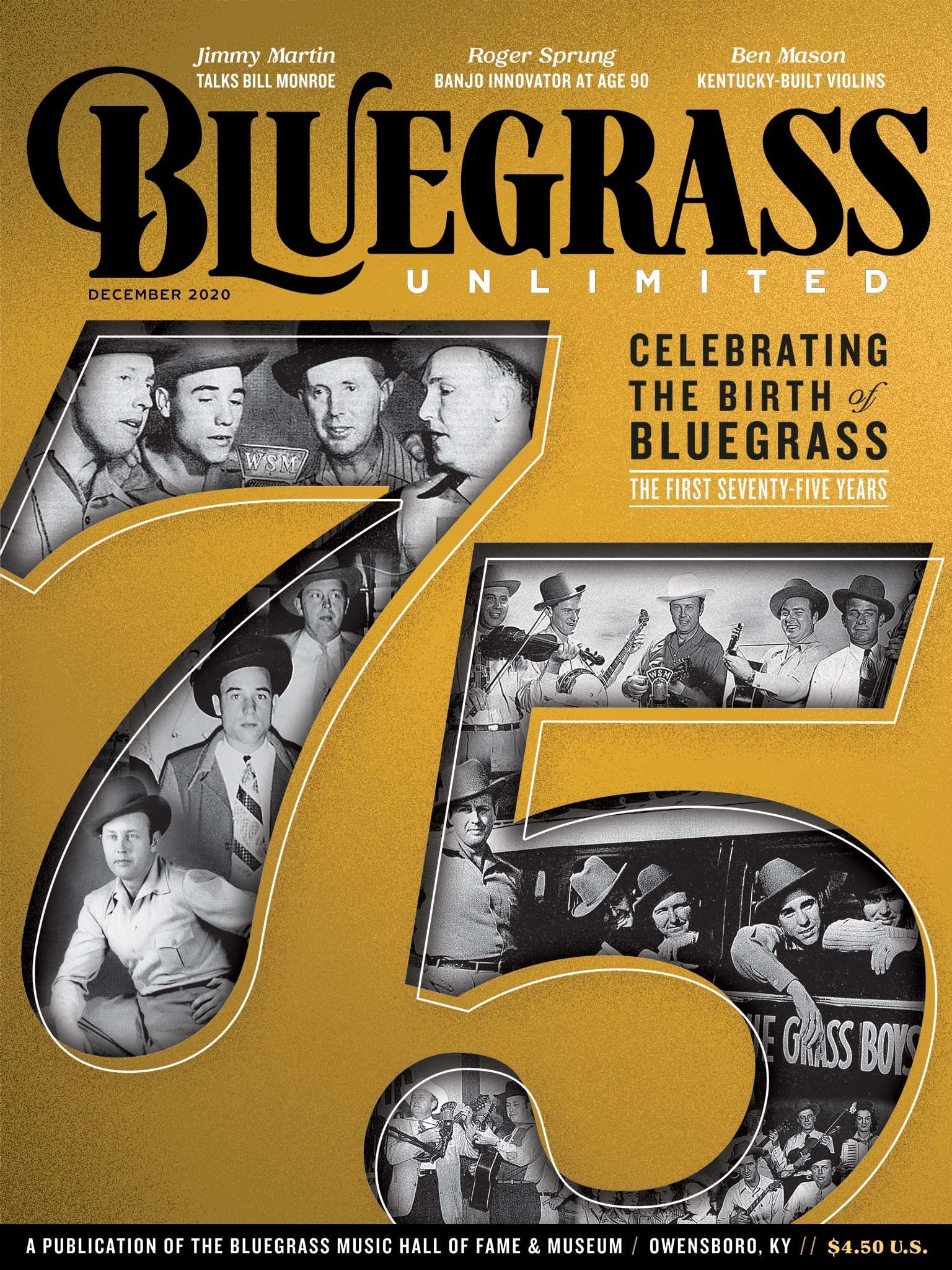Home > Articles > The Archives > 1967 Reader Poll Results
1967 Reader Poll Results
Photos By Edwin G. Huffman
Reprinted from Bluegrass Unlimited Magazine
April 1968 (Volume 2, Number 10)
My first knowledge of the BU poll, as for most other subscribers, came whenI arrived at the last page of my December issue, I’ve always wanted to know more about the kind of people interested enough in bluegrass to subscribe to the magazine, and I was delighted at the opportunity presented by the poll. Sitting down to fill it out, however, was another problem. The questions allowedtoo much or too little leeway in many cases, thus being unnecessarily hard to answer. For example, did “favorite” mean all-time favorite or current favorite? Did the guitar category mean lead or rhythm? Disliking Dobros in the music, should I skip that category or fill in my favorite player nevertheless? Was I obligated to name the musician I thought best in each category, or could I name one not as good but more pleasing to my ear? Or perhaps “favorite” could be interpreted to mean a personal friend and I should consider the poll a popularity contest. What on earth did “misc. instrument” mean? Should my choice of band specify members or would its present composition be assumed?Which records came out in 1967 and which actually came out before then? How was I to explain that I usually attended shows in my area but certainly not “always”? Did “average income” mean as a family or an individual? Then too, how did one handle the problem of being, say, 20 or 30 years old? Would you mark the 15-20 box or the 20-25 box? (Very careless of somebody to let that error slip by.)
These problems and quite a few more were experienced by most of the pollrespondents, with everyone deciding for himself how to handle each. Of course, that created special difficulties for finally tabulating the results: In somecases this actually became two or more separate polls because two or more separate approaches were used to fill it out, and yet all the information had to be combined in the end. Where more than a single answer was given in any category, it unfortunately became necessary to ignore part of the information in order to give each respondent equal voice. That meant arbitrarily picking thefirst answer written even though the respondent might have bypassed that onehad he made the decision himself.
One other word before reporting actual results:My purpose in accepting the job of organizing this information was to help satisfy enormous curiosity about other bluegrass followers. I considered the poll, not as a popularity contest for revealing the relative standings of bands and musicians, but as a way of learning something about the nature of the audience. My handling of results developed from that point-of-view.
The total number of responses from which these figures are tabulated is 241. Of these, several are relatives or friends of subscribers, so that we can sayabout 200 of approximately 1000 total subscribers to BU answered the poll, actually twenty per cent. That, by the way, is an unusually large percentage responding. (I suspect many of us have secretly been dying to give our opinions on a lot of these subjects, and even more might do so in the future if questions were less confusingly asked.) However, it must be mentioned that even so large a number cannot be automatically thought of as a typical sampleof bluegrass fans: The results of this poll can only be considered typical of the type of bluegrass fan who not only subscribes to a magazine on bluegrass but also answers a poll issued by that magazine. That is surely rather a select population.
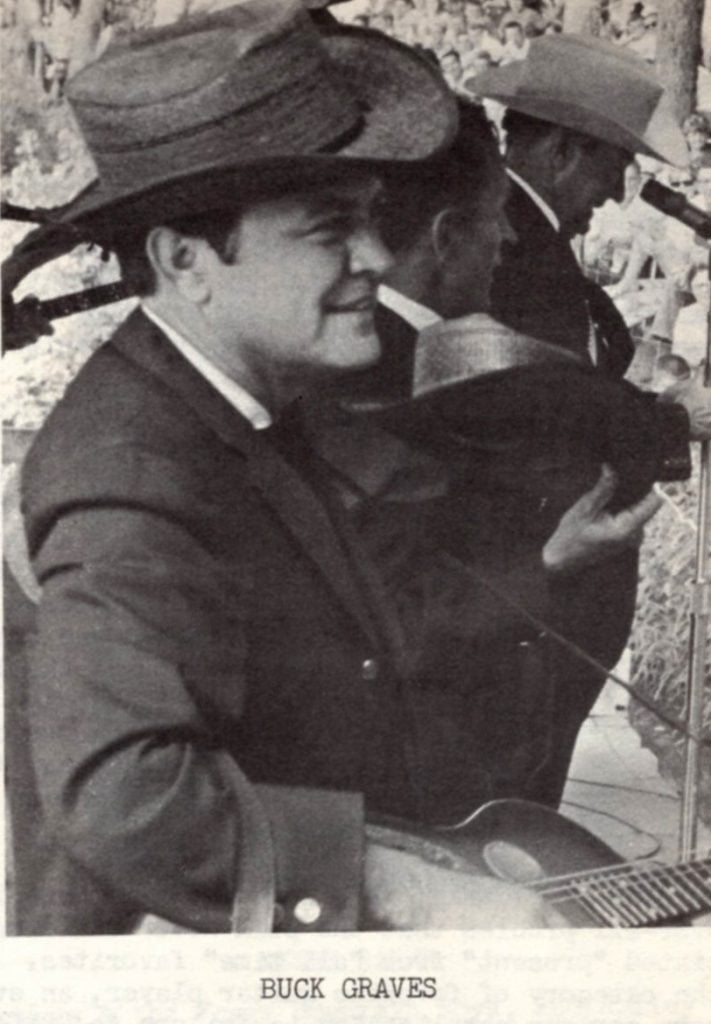
In certain categories selection of a favorite was apparently very easy, with one musician overwhelmingly standing out above the others.In othercategories there was also one clearcut choice, but it was not nearly so overwhelming. Finally, several categories showed no really strong first preference at all. Moreover, in nearly all cases the selections behind the frontrunner were extremely close. In terms of learning about the tastes of our subscribers, many of these placements differ by so few choices that chance rather then real preference may have caused the differences.
The only two categories in which more than half of the respondents were in agreement were that of favorite mandolin player and favorite Dobro player: Here, respectively. Bill Monroe was namedby 140 and Buck Graves by 131. Behind Monroe were John Duffey, Jesse McReynolds, and Bobby Osborne, in that order; behind Graves were Shot Jackson, then Tut Taylor and Russ Hooper (the latter two tied). In both cases there was a gap of well over a hundred between first and second place, with less than ten altogether then separating the next three. Also, in both cases, the long series of musicians named by only a few (every category had many of these) fell behind the first four by another definite (but very, very much smaller)gap.
Another category wherein the first choice was by more than twice as many as the second: George Shuffler was definitely the favored bass player, named by 75 respondents (spelling varied greatly on “Shuffler” but the meaning was usually clear.) In this category, the next highest number were those unable or unwilling to make any selection at all, many indicating that they generally paid too little attention to bass players as individuals. (A large number had also failed to name a Dobro player, but in this case they often explained that they did not consider the Dobro a proper bluegrass instrument.)
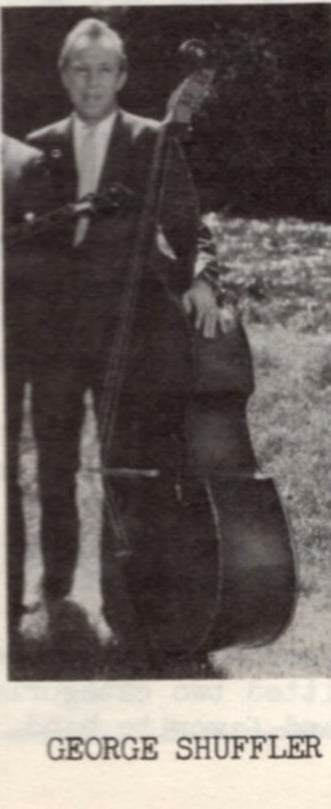
After Shuffler, Tom Gray held a relatively clear- cut second place, followedby an also clear third choice of Jake John Palmer, Jimmy Monroe and then BillYates (in that order) also were named often enough to differentiate them froma very long list (forty) of bass players each favored by only a few.
Earl Scruggs was a clear first choice as banjo picker, but not by the above margins: He wasnamed by under 60, while Don Reno in second position was named by over 30. Moreover, Ralph Stanley was only three behind Reno, an extremely slight difference considering the numbers involved. In this category the order would more accurately be represented this way:Scruggs,—gap, —Reno, Stanley, —gap, — Bill Keith, —gap, —Sonny Osborne, Eddie Adcock and Bill Emerson (latter two tied), —gap, —Allen Shelton and Walt Hensley (tied), Doug Dillard and Don Stover (tied), J. D. Crowe, —gap, —and then twenty morewith a few each. (This may seem an unnecessarily complicated way of reporting data when each musician could simply be numbered, but just giving the order would not reveal that some were separated by many while others were so even as to be essentially indistinguishable.)
In the category of tenor singer, there are four clear positions: The first is held by BillMonroe, the second by Bobby Osborne, the third by John Duffey and Ralph Stanley (in that order), and the fourth by Jim McReynolds. Lead singer is a more complex choice, however, with Lester Flatt slightly in front, then a cluster for second position of Jimmy Martin, Bill Monroe and Red Smiley (tied). Carter Stanley, Mac Wiseman and Charlie Waller (tied), all so close as to be barely distinguishable. Then a third position would be Bobby Osborne. These are all so close that the total number of responses separating Osborne from Flatt is under fifteen.
As said previously, in all categories there is an over-all problem that the poll never differentiated “present” from “all time” favorites. In the category of favorite guitar player, an even more serious complication is failure to differentiate “rhythm” from “lead”. This is undoubtedly one of the reasons why placements here are so close together, with Doc Watson ahead, Charlie Waller next, Red Smiley holding a third spot, and Jimmy Martin and then Clarence White fourth. There are a number of others who were named by more than a few respondents; Don Reno, Bill Harrell and Earl Scruggs (tied), Lester Flatt andMac Wiseman (tied), Johnny Herald and Carter Stanley (tied).
To my mind the fiddle player category is one of the most interesting. Forty-six different fiddlers are named, many of them excellent choices, and this suggests great diversity of taste rather than simply a number of local heroes. Kenny Baker, preferred by 31 respondents, leads this long list: Richard Greene, Chubby Wise, and Paul Warren (in that order) are the next grouping, followed by Tater Tate. Then come Byron Berline and Scotty Stoneman (in that order). Jimmy Buchanan, Curly Ray Cline, Mac MaGaha, and Buck Ryan are all tied, as are Vassar Clements and Benny Martin, right behind. In this category everyone seems to have his own ideas and there are no areas of strong agreement.
Unfortunately, the second BU issue to contain the poll accidently omitted two categories, that of favorite composer and favorite band. Therefore, 63less responses were available for these categories than for all the others. Of those who did have the opportunity to choose here, a good number were unable to think in terms of composer, and made no choice. Bill Monroe, then Carter Stanley, and finally A. P. Carter, held the only three significant positions. Several non-bluegrass composers were named here by one or two, and it might also be argued that A. P. Carter never wrote directly for bluegrass. However, on the strength of the number of his songs now a part of every bluegrass musician’s basic repertoire, he deserved to be considered.
Now we come to the category of primary interest to many, that of favorite band. Here the question of “present” compared to “all time” was apparently quite crucial, and many felt the need to mention it. In fact, although Bill Monroe’s band took first place by more than twice that of the next choice, many respondents specified which Monroe band they meant, that is, the actualcomposition of the Blue Grass Boys. Moreover, the Stanley Brothers and Ralph Stanley, specified differently, were tabulated separately. Had the Clinch Mountain Boys been totalled up regardless of that differentiation, it would have been in second position.
Ignoring all these complications, bands came in the following order: Bill Monroe & the Blue GrassBoys, The Country Gentlemen, Lester Flatt, Earl Scruggs & the Foggy Mountain Boys, Red Smiley & the Blue Grass Cutups, The Stanley Brothers & the Clinch Mountain Boys, Ralph Stanley & the Clinch Mountain Boys, The Dillards and Jim & Jesse & the Virginia Boys (tied), then Jimmy Martin & the Sunny Mountain Boys, The Osborne Brothers, and Don Reno, Bill Harrell & the Tennessee Cutups (the last three tied.)
1967 Reader Poll Results Part II
Reprinted from Bluegrass Unlimited Magazine
May 1968 (Volume 2, Number 11)
Now that the very broad categories of preference have been covered, we can get to some of the more interesting breakdowns of information that tell far more about the poll respondents. For example, there is the item called “Favorite Period”, one which had been rather arbitrarily broken up into “1945-1954″, “1954-1960” and “1960-1967” by the poll constructors. This can roughlybe considered early, middle, and recent bluegrass, although the actual dates chosen as limits for the three would have varied, depending on the personal biases an individual poll maker might have. (The first period in particular could easily have been divided in two by natural changes in the development of the music, but I for one was grateful that I didn’t have to choose between them.)
First, in terms of numbers, it can be said that preferences followed the given order, with “1945- 1954” ahead, then “1954-1960” and last “1960-1967”. The number of choices separating them amounted to only about ten in both cases. Next, detailed analyses of the differences between the first and third groups allow us to speculate about what governed people’s preferences of period.
Those who preferred the early period and those who preferred recent bluegrass did not differ in the type of backgrounds from which they came (“Rural”, “Suburbs”, “City”), but they did differ in age. That is, (as would be expected) the younger respondents were more likely to prefer the latest period, while the older ones preferred the earliest period. This difference amounted to a reversal in order of preference for the “15-20” group of respondents (they choose “1960-1967”, then “1954-1960”, with “1945-1954” last), but the “20-25” group did not differ from the original pattern. Age alone could not therefore have governed the other differences between the “early” and “recent” groups.
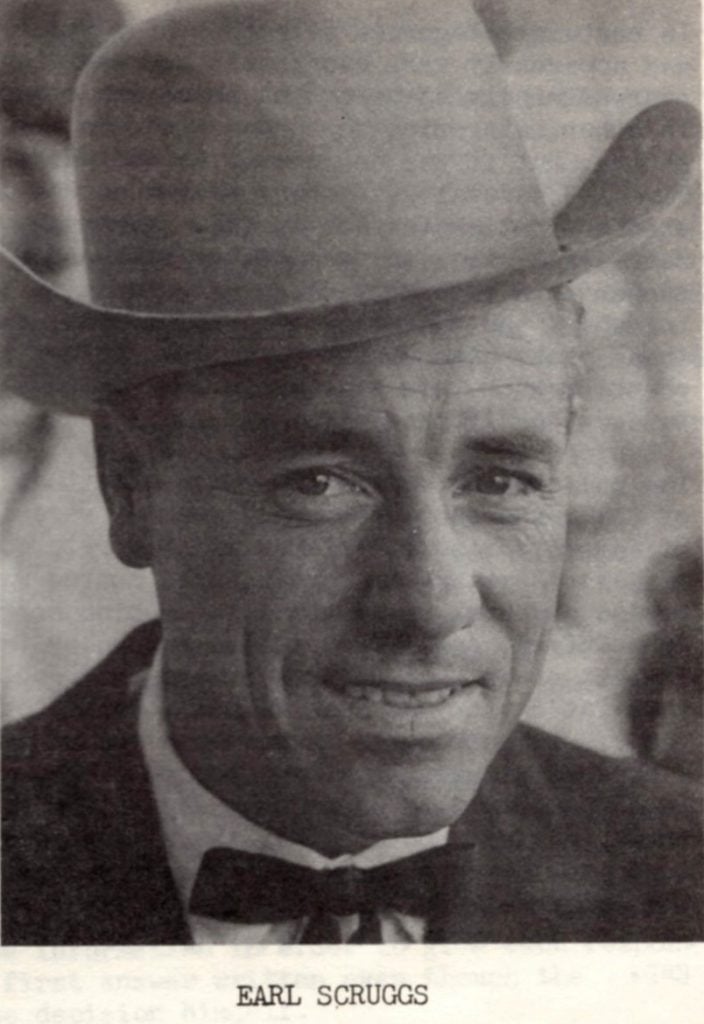
The two groups differed a great deal in their preferences on the banjo:Scruggs fell from a strong first position for the “1945-1954” group to a close second for the “1960-1967” group, replaced in first position by Bill Keith (fifth place for those who preferred early bluegrass and fourth overall.) One other significant difference in the banjo category was Emerson’s failure to be named by those who preferred recent bluegrass, but the change that governed differences in the banjo category was apparently essentially a Scruggs-Keith issue: In short, one basic difference distinguishing respondents who prefer the most recent bluegrass from those who prefer the earliest is strong taste forKeith’s style of picking, a taste so strong that it overcomes the otherwise outstanding preference for Scruggs.
In the guitar category, the “earlys” like Smiley and Reno more than the “lates”, while the “lates” like Waller and Martin more than the “earlys”. This is adefinite trend but is not so strong as to be considered an essential element differentiating the two groups. A switch in placement between McReynolds andOsborne in the mandolin category is similarly clear but not essential, with the former preferred by the “earlys” and the latter by the “lates”. In neither of these categories is the first position challenged for either group, nor are the proportions sufficiently high to suggest that these differences are what basically cause respondents to prefer one period over another.
In bass and Dobro categories there are no order reversals at all, the two groups pretty much agreeing in their preferences.
There is a major change in the fiddle category which is probably important to the underlying differences in taste between the two groups: While none of those who prefer recent bluegrass name Chubby Wise, he is named often enough by those who prefer early bluegrass to be a close second.
In singing there are also strong differences: Carter Stanley and Charlie Waller exchange positions for the two groups in the lead singer category.
Monroe remains second choice for both,but Stanley is first for those preferring early bluegrass while Waller is first for those preferring late. In the tenor singer category, the order for those preferring early bluegrass is Monroe, Ralph Stanley, Bobby Osborne, and then John Duffey. For those preferring recent bluegrass the order is Osborne, Monroe, Duffey, and then Stanley. Thus, in singers it would appear that taste for Bill Monroe and the Stanley Brothers is essential in differentiating those whoprefer early from those who prefer recent bluegrass.
The category of favorite band involves a considerable change of order for the two groups: Those preferring early bluegrass have Bill Monroe and the BlueGrass Boys in first place by an extremely wide margin, the Stanley Brothers second. Red Smiley and the Bluegrass Cutups third, Flatt and Scruggs and the Country Gentlemen tied for fourth, and (as would be expected) the Dillards named by no one. Those preferring recent bluegrass, on the other hand, have the Country Gentlemen in first place by a very slight margin, Monroe’s Blue Grass Boys second, Flatt and Scruggs third, the Dillards fourth, and the Stanley Brothers tied with Red Smiley’s band way back in sixth place.
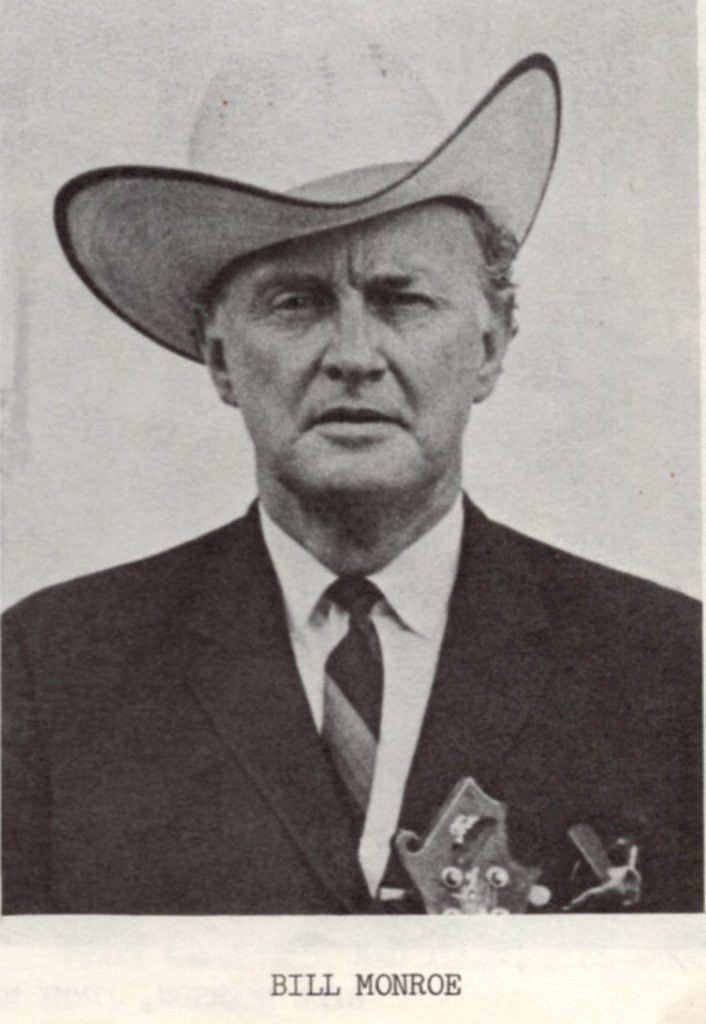
These results can be looked at in one of two ways: Either those who preferred early bluegrassare still clinging to sounds out of the past (as characterized by Monroe’s Blue Grass Boys and the Stanley Brothers of the late’40s and early ’50s), or they now seek out sounds epitomized for them by theseearly archtypes. Those who prefer recent bluegrass, on the other hand, are talking more about the sounds typified by Bill Keith, Richard Greene, Bobby Osborne and Charlie Waller. In other words, it cannot be said (with any sort of assurance) that the larger group dislike what is now being played. It can only be said that they tend to prefer banjo sounds reminiscent of Earl Scruggs to those of Bill Keith; that they seek Chubby Wise type fiddling; that they are attracted to Bill Monroe and Stanley Brothers singing styles, etc. Because of this they now prefer for example, Red Smiley’s present band to the Country Gentlemen or the Dillards. The smaller group, on the other hand, finds its patterns of taste represented by exactly those musicians and bands the other rejects, so that it will seek out Keith-style pickers, for example, and will prefer Duffey-type tenor singing to any similar to Ralph Stanley.
In doing the same type of analysis for differences between respondents from a rural and from a city background, we find two far less distinctive populations than when divided by favorite period. (The number of respondents from the city and the number from a rural background were both exactly 71, with 83 from the suburbs and about 13 from variously mixed backgrounds.) Total lack of any guidelines for making decisions on labelling one’s background may have played a part in this. For example, if one were born in the country but moved to the city at age six, which would one mark? A future poll examining this aspect of our subscribers more carefully could be arranged to eliminate this sort of doubt, but with the present poll it’s not really possible to know exactly what these labels mean.
There was a significant difference in the proportions by which the first three choices for banjo picker were made: For those from a rural background,Scruggs was clearly first, with Reno andStanley tied for second; for those from the city, Scruggs and Reno were tied for a strong first, with Stanley trailing in second. However, there was no real change in order of preference, just a tendency toward a taste for Stanley combined with a little less inclination toward Reno among “country-born” as compared to “city-born” respondents.
In all other categories down to lead singing there were almost no differencesbetween the two groups, except for a tendency for the “city-born” to prefer (or perhaps to have more familiarity with) Kenny Baker on the Fiddle and George Shuffler on the bass to a somewhat greater degree than the “country-born”. In the lead singer category, however, a change of order did occur between the two groups: Those of rural background have Flatt first, Martin second, and Monroe fifth;those of city background have Monroe first, Flatt third, and Martin fourth (Smiley and Wiseman come in there also but the groups do not differ in their feelings for them, the changes being caused by the preference differences about the three listed.)
Band choices again differentiate the two groups somewhat: although Monroe’s Blue Grass Boys leadfor both, some of their strength and much of Flatt and Scrugg’s strength (they go, surprisingly enough, from second place for the “country-born” to fourth place for the “city-born”) has gone to pull the Stanley Brothers up from sixth with the “country-born” to third among the “city- born”. (Again, only mentioned are those wherein the groups differ, the purpose of this type of analysis being to understand such differences.)
These two groups of respondents are characterized by two other major differences: Of the 19respondents to the poll who were forty years or older, a full 12 of them were of rural background (three times as many as were of city background.) Also, of the total seven respondents who never reached high school (these numbers, of course, do not say anything at all about those respondents failing to mark anything in a category), six were from a rural background. Moreover, almost twice as many of the “city-born” went to college(nothing said about how long) as only went to high school, but for the “country-born” a majority did not enter college.
We can sum up the differences between those with rural and those with city backgrounds by saying that not a great deal has been revealed by this particular system of dividing our respondents.As would be expected, they differ significantly in age and in education, so that any other differences might well be more related to age, education, or both, than directly to background.A more clear-cut description of backgrounds might have produced far more meaningful differences, and more information should be obtained on this at another time.
Now to the question of age grouping. The order of frequency in the various groups was as follows: There were more respondents at the 25-30 age level than any other. The second most common was 20-25, 30-35 third, 35-40 fourth, 15-20 fifth, 40-45 sixth, and the “over 45” group was smallest. It was difficult to determine how these groups should be compared. The number in the youngest group and in the oldest two groups were equal, both 19, and comparing the extremes is always very interesting. However, dividing only 19 people among the various choices in each category often gives too few to learnanything conclusive about true preferences. Another analysis was therefore also made, comparing the 20-25 group (51 individuals) with those over 35 (totalling altogether 48 individuals.) Thus, either one or both of these analyses was examined to see how age seems to relate to preferences.
In the banjo category both comparisons agree in revealing that the younger respondents give far more consideration to Keith than do the older, while the older seem to have equivalent regard for Stanley that the younger do not have. In the guitar category, a change can be seen between the two groups in their attitude toward Waller, who is more popular with the younger than with the older.
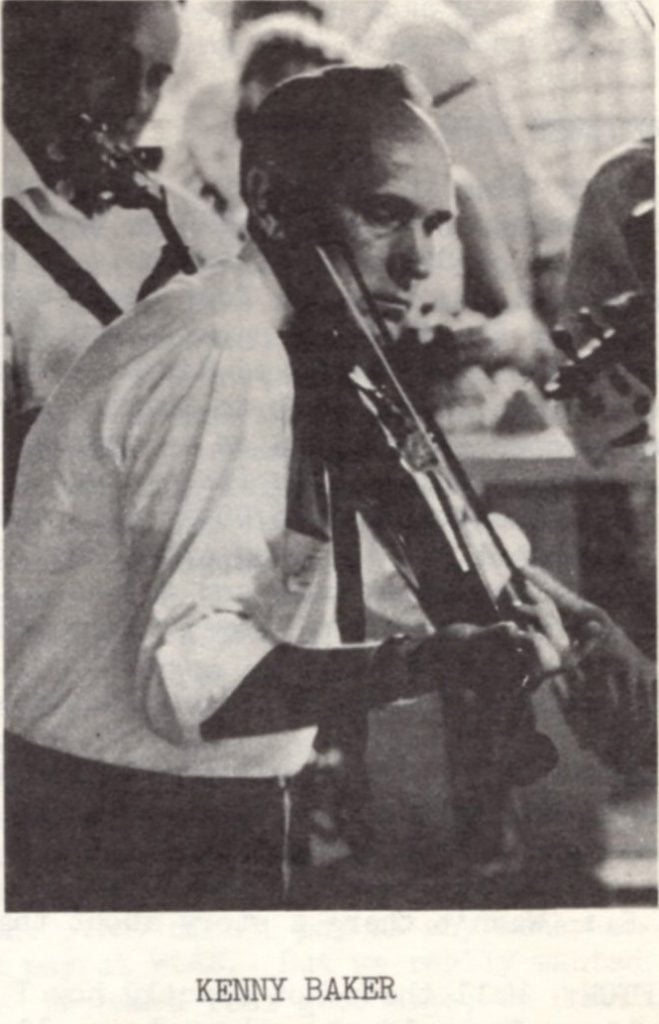
Fiddle category, apparently quite sensitive to all differences because of its lack of outstanding frontrunners, shows order changes in terms of age level as well: The older groups have Wise infirst place and Kenny Baker in second, witha considerable gap between them. The younger groups have Baker ahead, others such as Greene also being well ahead of Wise. (It is interesting that change in attitude toward Chubby Wise’s fiddling shows up in almost any breakdown of the over-all category, from almost any point-of-view. Perhaps some of the readers may have ideas as to why that should be.
In mandolin, although McReynolds receives more consideration from older than from younger respondents, there is no order change. In bass, those of the younger groups tend to think less well (or just less often) of Tullock; Shuffler being the one to profit from this change (although he maintains clear first position regardless.) The Dobro category shows little meaningful alteration.
Singing is another area apparently sensitive to almost any type of breakdown of the over-all sample. When lead singing is broken down by age level, Flatt seems to be the center of the attitude change: The older respondents put him ahead of anyone else, but for the younger oneshe is named by relatively few. In his place Monroe, Smiley and Martin seem to get more consideration. When tenor singing is broken down by age level, Osborne is apparently the center of contention. The younger groups give him more consideration than do the older.
There seems to be a tendency for the Flatt and Scruggs band in general to arouse less interest among the younger as compared to the older respondents.This apparently holds true all along the line, whether considering the band members as individuals (except for Buck Graves) or the band as a whole. Incidentally, a similar tendency occurs for Jim and Jesse. Both of these groups, obviously doing extremely well with young people just now in music other than bluegrass, have lost ground with the type of young fan involved enough to subscribe to a bluegrass magazine.The older bluegrass fan, however, probably still thinking primarily of their past performances, continues to rate them quite highly. (From what we hear about the audiences toward which these bands now direct themselves, this development shouldn’t bother them at all.)
In other words, while younger audiences in general may really love the new Flatt and Scruggs or Jim and Jesse, young bluegrass fans probably rarely even hear them. If these young fans listen only to current bluegrass, they may well prefer modem sounds (e.g. Osbornes) to the more traditional (e.g. Ralph Stanley), but they nevertheless hear relatively little of those groups who in recent months have declared themselves out of bluegrass. (Perhaps the recentrevival of the “Foggy Mountain Breakdown” might be altering that development for Flatt and Scruggs just now, but the poll came out largely before this new revival really took hold.) Lack of exposure is the only explanation I can think of for this unexpected reaction to Flatt and Scruggs even among those fans who first became acquainted with the field by watching“The Beverly Hillbillys” on TV, but it may be totally incorrect. Perhaps real taste is involved and is actually related to the sound itself. (There may be other possibilities I haven’t considered at all.)
1967 Reader Poll Results – Part III
Reprinted from Bluegrass Unlimited Magazine
June 1968 (Volume 2, Number 12)
The only other detailed examination of choices was done for those respondents from Maryland and Virginia. There were 40 polls returned by Maryland residents, by far the most from any one state. This being the home state of the magazine, it was of interest to evaluate the local biases. Virginia, atleast its northern sections, can also be considered home territory for many associated with the magazine, but of the 28 respondents from Virginia it is impossible to tell how many are from the “local” area. Nevertheless, these two states returned the largest number of polls. (Ohio-18, Pennsylvania-17, New York-12, New Jersey-10, Califomia-9, Connecticut-9, Indiana-8, Michigan-7, Kentucky-6, North Carolina-6, Illinois-5, Maine-5, Massachusetts-5, West Virginia-5, Wisconsin-5, District of Columbia-4, Texas-4, Georgia-3, Iowa-3, Minnesota-3, Oklahoma-3, Rhode Island-3, Florida-2, Qrtario-2, Oregon-2, Quebec-2, South Carolina- -2, Tennessee-2, Colorado-1, England-1, France-1, India-1, Manitoba-1, Missouri-1, Montana-1, Ottawa-1, Sweden-1, Washington-1.)
Among Maryland residents, Keith (banjo) doesn’t do as well as he does with the population of respondents as a whole. Waller (guitar) does far, far better than he does over-all, and Clarence White (guitar) is also somewhat more popular than he is with the total population. Maryland is also one of the areas rather big on Wise (fiddle), by the way. And rather unexpectedly to me, McReynolds is quite popular on the mandolin among Maryland residents (I had expected to see Duffey have this local popularity, as he did in Virginia.) The anticipated local popularity of Tom Gray (bass) is lost statistically because of Shuffler’s equal upsurge of local popularity. Charlie Waller’s local popularity wasexpected again in lead singing, but instead Carter Stanley is evidently the Maryland favorite (true in Virginia as well.) This Stanley Brothers popularity in BU home territory is equally true for Ralph in tenor singing, and for the band itself over-all (even more so in Virginia, Stanley Brothers home state.) By the way, the Country Gentlemen are also extremely popular in Maryland (as expected), but the Flatt and Scruggs band is never named (?).
As said above, the reason for reporting differences between Maryland residents and the over-all population of poll respondents is the close relationship of BU to this particular subgroup.While we cannot assume that the BU staff always share the biases of the Maryland poll respondents, we can expect their biases to have more in common than either would have with, for example,New York or California groups. However, as can be seen from the above rundown, BU has rather a wide spread following and pulls in opinions (with many local heroes named) from just about every area of the country (and beyond).
BU also, it would appear, has subscribers with every level of education— 140 respondents with some sort of college contact, from less than one year to all types of professional and graduate schools; 89 with some sort of high school contact; 7 with only grade school contact (probably more college-graduate-type subscribers answer polls than any other type subscribers, and the subscribers as a whole might not be as well educated as the respondents seem to be.)
Amount of income, surprisingly unrelated to educational level, also varied greatly (categories were often too broad to be informative, and there was no word of how many wage earners there were in a family, whether the respondent was the wage earner, etc.): $5,000-$10,000—106, under $5,000 (including some of the students without income but not including those who checked nothing) —46, $10,000-$15,000—44, $15,000-$20,000—9, over $20,000—4. This category was left unchecked by 33 respondents, and among the variety of reasons for this was a natural reluctance to reveal such personal information. However, my interest in income, as poll tabulator, was a totally impersonal, statistical interest. In this particular poll it happened to have very little significance anyway, but one day such information might conceivably have bearing on some aspect of bluegrass.
Unfortunately, not a great deal can be said about the occupations of the respondents because everyone had his own name for what he does and it was impossible to know when these names actually stood for the same things. Altogether there were about 45 students (all kinds), more of these than of any other one category. There were approximately equal numbers of unskilled, semiskilled and skilled laborers, a number of teachers (from grade school to graduate school), government employees, white collar workers, blue collar workers, businessmen (at all levels), and professionals. There were truck drivers, firemen, farmers, one minister, and one seminarian studying for the priesthood. Several librarians (of various kinds) were respondents, perhaps more than would be expected in a random sample of this size (is there a connection between bluegrass and library work?) Finally, of special interest to us, at least 9 (some of those who gave no personal information may also have been musicians) made their living entirely from some aspect of music, whetherrecord-selling, record-making, teaching, playing, etc. (Incidentally, as a whole they don’t do too well, six of the nine making under $5,000.)
Nothing is going to be said in this report about the other types of music our respondents enjoy (from all other to no other, with every possible variation in between), whether they attend shows in their areas (many said they do whenever they can but that few bluegrass shows are ever around), what radio stations carry bluegrass (many said none), whether they play instruments themselves (a surprising number had apparently never attempted to play anything themselves, though others seem to attempt everything), etc.
I was particularly interested in how people first came to bluegrass, but, unfortunately again, the poll allowed for so much leeway in answering that a great deal of information was lost. Several general themes were very frequent. The older groups, for the most part, were around while the music itself was developing, and they talk about hearing Monroe on the Opry in the early 40s. Another group says they grew up with the music in their homes and on their radios; they were of all ages. Another group came to bluegrass through the late folk music revival, often first while at college but not necessarily so, nor necessarily only younger people. Finally, another group (and these do tend to be pretty much only younger people) first were attracted to bluegrass by seeing Flatt and Scruggs or the Dillards on television. Because these groups were not sufficiently clearcut, no analyses could be made of how their tastes differ. More on this will have to await future polls.
Many poll respondents were unable to fill in the record categories, either because they were unfamiliar with 1967’s crop of singles and albums, or because they found making a choice too difficult. A number of people specifically stated that they had no opportunity to hear recent records, particularly singles, as the local radio stations would not play them. In other cases, they were not sure which of their recent favorites actually had come out in 1967, and so put down what they liked regardless of release date.
Because some of the respondents limited themselves to 1967 while others did not, results will be reported in two ways. On the one hand, naming the performer or group total, ignoring the specific record named, gives an idea of those being most heard over-all. On the other hand, considering only records of1967, the specific discs receiving the highest number of choices will be named.
The group chosen most often as producing a favorite single record was the Osborne Brothers, named by more than twice as many as second choice. The next four were separated by only three altogether. They were Bill Monroe, thenFlatt and Scruggs tied with the Country Gentlemen in third position, and Ralph Stanley in fourth. Behind these were a long series with one or two choices eachexcept for Jimmy Martin who was named by five).
Limiting the records as far as possible to 1967 (for information on records I have primarily gone back into my old BUs—please forgive any errors you may spot), the Osbornes still hold first place with their “Roll, Muddy River”/”Making Plans” (Decca 32137). However, Ralph Stanley has moved up to second place because of the strong popularity of his “That Beautiful Woman”/”Row-hoe” (King 4-5-6113). Monroe’s “Pretty Fair Maid In The Garden”/”When My Blue Moon Turns To Gold”.
(Decca 32075) is third, followed by “Matterhorn”/”Battle Hymn Of The Republic” (Rebel F-267) of the Country Gentlemen, then their “Baby Blue”/”Spanish Two Step” (Rebel F-265, this was reviewed in the February BU issue and may actually have been released in late 1966), and finally Flatt and Scruggs’ “Foggy Mountain Breakdown”/”Cabin In Caroline” (Mercury 72739). In each case, the first-named side of the record was the more often listed of the two sides, but placement came about by combining the number of choices for both sides together.
Before going on to albums, something more should be said about the choices already named. The foremost question to me is the influence of local radio on these choices. My own experience in the Washington, D. C. area has been fairly frequent hearing of the Osborne and Country Gentlemen selections on a local country music station, where I have heard Monroe’s once or twice and have yet to hear Ralph Stanley’s Record. My understanding has been that this pattern is repeated in most parts of the country, and if this is true at least apart of the respondents must have heard the records of their choice elsewhere than on the radio. This idea leads to the question of how the above results might be altered if all the records were given equal play (whether more or less)on the radio.
Moving to recent albums, radio probably plays a somewhat less important role here than with singles. Monroe holds first position in albums by a considerable margin, followed by Flatt and Scruggs. Another sizable gap leads to the Country Gentlemen, then Jimmy Martin and then the Stanley Brothers, all quite close together in third, fourth and fifth positions. The Osbornes and Red Allen are tied for sixth, Red Smiley is seventh, and finally the Dixie Gentlemen with Tut Taylor are eighth, differentiated from a good number of others, each receiving one or two choices.
The following are the specific records that contributed largely to the above order: Monroe’s “Blue Grass Time” (Decca 4896) holds a comfortable lead. Flatt and Scruggs with Doc Watson are second, with “Strictly Instrumental” (Columbia CL 2643). Jimmy Martin’s “Big Country Instrumentals” (Decca DL 4891) fills third position. Skipping several 1966 albums, we end with the Dixie Gentlemen with Tut Taylor, their “Blues and Bluegrass” (Tune TRC 1001) in fourth.
The most difficult category of all to analyze has been “favorite bluegrass record of all time.” Approximately two-thirds of the respondents gave a single song title, usually with performer or band included (but, unfortunately, not always) as their answer. The other third named an album, also usually with band or performer. There were a handful who gave one of each, and a rather large number who left this category blank because they simply could not specify one favorite.
As has consistently been done throughout this poll analysis, only first answers were entered into totals. It was also necessary to omit the few titles lacking performers that could not be traced (whenever a song brought one group or performer overwhelmingly to mind it was arbitrarily attributed to that performer.)
Results will be reported in terms of totals for each performer for albums, for individual titles, and for both together. Any record that was named by a significant number of respondents will also be reported, again albums and singles separately. Monroe was named by more than twice the second choice for both albums and for individual songs. The order for all-time favorite albums was as follows:Monroe first, Flatt and Scruggs second,the Stanley Brothers and the Country Gentlemen tied for third, Red Allen and the Dillards tied for Fourth, and Jim and Jesse fifth. (There were, of course, a number of others named by one or two.) The order for all-time favorite individual songs was: Monroe first, the Stanley Brothers second, Flatt and Scruggs third, the Osborne Brothers fourth, Mac Wiseman and the Country Gentlemen tied for fifth, and Reno and Smiley tied with Jimmy Martin for sixth (again with a number of others selected by one or two.)
Combining the totals, Monroe in some form or another performed the all-time favorite bluegrass record for almost as many respondents as all others puttogether. Flatt and Scruggs and then the Stanley Brothers were second and third, extremely close to each other. Much further behind came the Country Gentlemen, then the Osbornes and Wiseman tied for fifth, Red Allen and the Dillards tied for sixth, and Jimmy Martin tied with Jim and Jesse for seventh.
With the entire history of bluegrass available from which to choose, no record was named by more than six respondents. These are all the ones named by three or more: Albums—Monroe’s “Original Bluegrass Sounds” (5), “The High Lonesome Sound of Bill Monroe” (4), Monroe’s “I Saw The Light” (3), Flatt and Scruggs’ “Country Music” (3), and the Dillards’ “Live (Almost)” (3). Individual performances—Monroe’s “Molly and Tenbrooks” (6), Monroe’s “Uncle Pen” (5), Monroe’s “Footprints in the Snow” (5), Flatt and Scruggs’ “Foggy Mountain Breakdown” (4), Monroe’s “Sweetheart of Mine, Can’t You Hear Me Calling?” (3), Monroe’s “First Whippoorwill” (3), Monroe’s “Get Down on Your Knees and Pray” (3), Monroe’s “Christmas Time’s A-Comin’” (3), and Monroe’s “Sweetheart, You Done Me Wrong “ (3). A large number of Monroe and Stanley Brothers classics were named by two.
Because Bill Monroe has played such a dominating role, not only in the history of bluegrass but in the specific attitudes and tastes of respondents to this BU poll, one other analysis of results suggests itself. Going over the individual sheets of each respondent carefully, only twenty-two percent of the total number make absolutely no mention of Bill Monroe whatsoever. In other words, more than three-fourths of the respondents placed Monroe as favorite inat least one category (often more than one), while this small group stands out as highly distinctive simply by this lack.Partly because I personally cannot imagine a bluegrass fan with the sort of tastes that would exclude Monroe, and partly because this group is unusual among poll respondents, an analysis was made of them. They proved to differ from the respondents as a whole in almostevery category.
Along with never picking Monroe (which by definition makes this group distinctive in all categories he dominates—mandolin, singing, composer, band, and all record categories), there is a significant reduction in the number of Stanley Brothers selections in all categories (banjo, singing, band).) Red Smiley also gets significantly fewer choices wherever he did well with the respondents as a whole (guitar, lead singing). Finally, in the fiddle category, Kenny Baker, Chubby Wise, and Byron Berline (in order of greatest to least difference) all are significantly less favored by this group than by the over-all respondents.
Of course, if some are down in placement, others must logically be up:Those who reject Monroe highly favor all aspects of the Country Gentlemen.Adcock is significantly increased in banjo category, Ferris in bass, Waller in guitar and lead singer, and Duffey in mandolin, lead singer and tenor singer.Finally, in the band category, among those who never name Monroe, the Country Gentlemen are preferred by three times the second place band. (Others who are especially well thought of by this group are the Dillards, Scotty Stoneman and Mac Wiseman.)
This particular poll, with all its complications and inadequacies, has provideda great deal of information but no clear conclusions. Perhaps two or three brief polls might be run each year, examining a variety of questions in detail, one at a time. For instance, a poll on taste in fiddle-players might be run, or one inquiring about the very first bluegrass respondents could remember hearing. A series of short polls, carefully written, would ultimately give more knowledge about bluegrass fans than a single poll that asks too many questions all at once.
